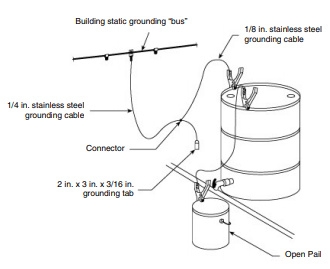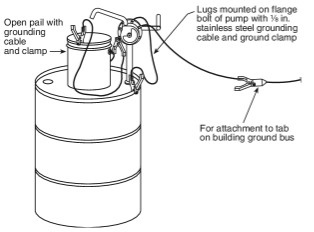- Home
- Loss Control
- Tech Sheets
- Bonding and Grounding During Flammable Liquid Transfer
Static electricity is a difference in electrical potential between two objects. If the air is dry enough, a difference in electrical potential or “charge” can occur. When an object with a different charge is touched, the static electricity rapidly equalizes between the two objects, creating a spark.
This rapid equalization of electrical potential can be catastrophic when handling flammable liquids. Filling one container of flammable liquid from another container creates friction between the liquid and the container and can produce a static charge. Under certain conditions, a spark may ignite the flammable vapors in the area.
Steps must be taken to equalize the difference in electrical potential between the containers. These steps are commonly referred to as bonding and grounding.
What is the Difference Between Bonding and Grounding?
The process of bonding and grounding can best be described as creating an electrical pathway between a dispensing container, a receiving container and an earth ground. The purpose of this pathway is to allow static electricity to safely dissipate into the ground.
Bonding is connecting two or more conductive objects with a conductor, such as a copper wire, which equalizes the difference in potential, or charge, between them.
Grounding is connecting one or more conductive objects directly to the earth by means of a conductive rod driven into the ground or connection to a cold-water pipe.
All connections must be made to clean, bare metal. No paint, rust or other material can interfere with the bonding or grounding connections, as this may add resistance to the equalization of the charge.
There are two types of bonding and grounding connections: permanent and temporary. Permanent connections can be made using solid or braided wires and should incorporate screw-type clamps, welding or similar means of attachment. Temporary connections should only use braided wires in conjunction with spring clamps, magnetic clamps or similar methods of maintaining metal-to-metal contact.
How to Safely Transfer Flammable Liquids
OSHA regulations and the Uniform Fire Code state that all Class 1 liquids (flash points below 100°F) shall not be dispensed into containers unless the nozzle and containers are electrically interconnected. Some common examples of Class 1 liquids include: alcohol, toluene, acetone and benzene. The flash point of chemicals and flammable liquids can be found on the Safety Data Sheet (SDS) that accompanies the product.
The following NFPA® illustrations show the two most common types of flammable liquid transfers. Figure 1 illustrates bonding and grounding using the gravity feed method. The bulk drum should be connected to a grounding system (e.g., a cold-water pipe or a conductive rod driven into the ground), and the vessel being filled should be connected, or bonded, to the bulk drum.
Figure 2 illustrates the bonding and grounding steps necessary when using a drum pump. Note that the pump is electrically connected to the bulk drum, the container being filled and the fixed grounding system.


Get in touch
Need help? We’re here for you! Whether you have questions or need personalized assistance, your local office is ready to support you.
Loss Control Insights
Stay informed with the latest news and receive actionable safety tips, all carefully curated by our team of experts.